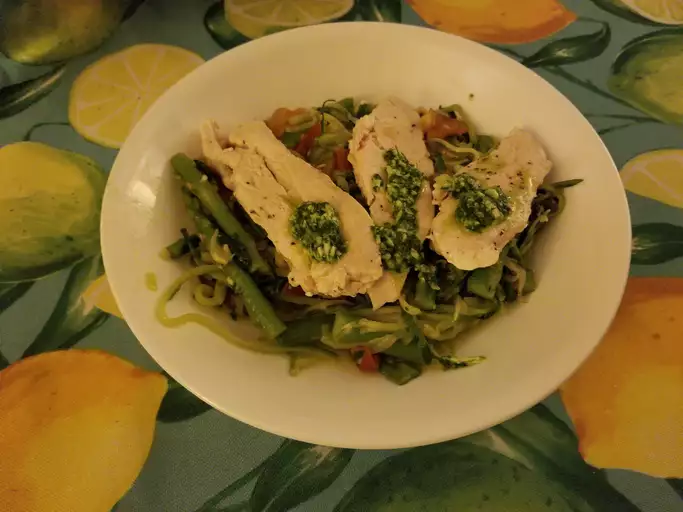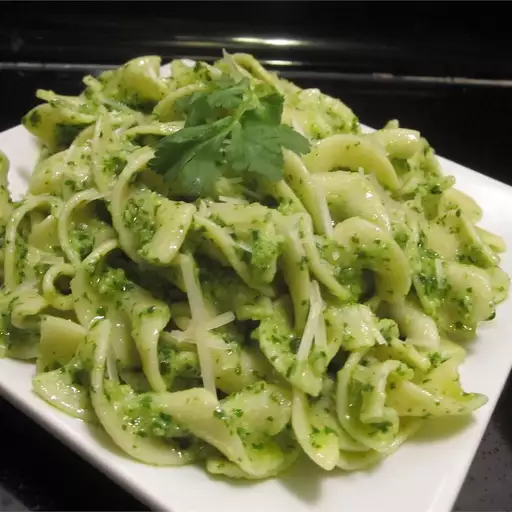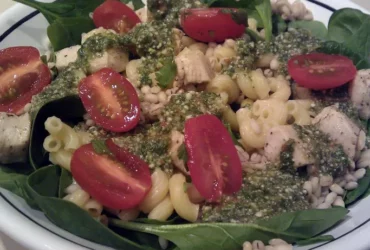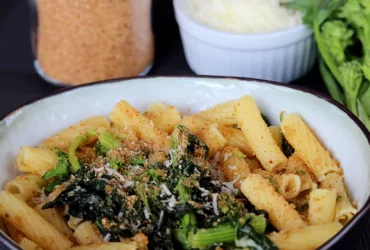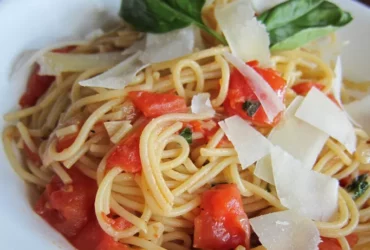Ingredients
Cilantro: The Star of the Show
Cilantro, also known as coriander or dhania in some parts of the world, is a small, fresh herb that has gained popularity in recent years for its distinct flavor and aroma. Native to the Mediterranean region, cilantro has become an essential ingredient in many cuisines, particularly Mexican, Indian, and Asian cooking.
The star of the show in our fabulous cilantro pesto recipe, cilantro’s unique taste is often described as a combination of citrus and herbal notes. With its bright green leaves, cilantro adds a vibrant pop of color to any dish it’s added to, making it an excellent choice for garnishes, salads, salsas, and even pasta sauces.
When selecting fresh cilantro, look for bunches with perky leaves and minimal wilting. The ideal time to use cilantro is when the leaves are young and tender, as older leaves can develop a bitter taste. Store your fresh cilantro in an airtight container or resealable plastic bag in the refrigerator to maintain its freshness.
One of the reasons why cilantro pairs so well with many ingredients is its adaptability to different flavor profiles. In Mexican cuisine, it’s often combined with chilies and garlic for added heat, while in Indian cooking, cilantro is frequently used as a garnish for soups and curries due to its delicate flavor.
In our fabulous cilantro pesto recipe, we’ll be using the vibrant flavor of fresh cilantro to create a creamy, herby paste that’s perfect for tossing with pasta, serving as a dip, or even using as a topping for grilled meats or fish. So let’s get started and explore the amazing world of cilantro!
1 cup fresh cilantro leaves
The star ingredient in our Fabulous Cilantro Pesto Recipe is fresh cilantro leaves, also known as coriander leaves or Mexican parsley. Fresh cilantro has a unique and distinct flavor profile that is often described as bright, citrusy, and slightly bitter.
The main reason why we need 1 cup of fresh cilantro leaves for this recipe is to create the perfect balance of flavors in our pesto sauce. Cilantro adds an amazing depth to the sauce, complementing the rich flavors of garlic, lemon juice, and olive oil.
To get the best results from your cilantro, make sure to choose fresh leaves with no signs of wilting or yellowing. You can either buy a bunch of cilantro at your local grocery store or grow it in your own garden.
When selecting cilantro, look for leaves that are dark green in color and have a fragrant aroma. Avoid using the older, woody stems, as they can be tough and fibrous.
To use fresh cilantro, simply chop it up with a sharp knife or food processor until you reach your desired consistency. For our pesto recipe, we recommend finely chopping about 1 cup of cilantro leaves to get the best flavor and texture.
1/4 cup freshly squeezed lime juice
- The first ingredient we’ll be using for our Fabulous Cilantro Pesto Recipe is 1/4 cup freshly squeezed lime juice.
- This may seem like a standard amount, but it’s actually quite crucial to achieving the right balance of flavors in your pesto.
- Freshly squeezed lime juice has a more vibrant and intense flavor compared to bottled or packaged versions, which can be lacking in depth and acidity.
- When you squeeze fresh lime juice, the membranes and pulp are broken down, releasing the oils and essences that give it its characteristic zing and citrusy taste.
- This acidity will help cut through the richness of the other ingredients, like olive oil and garlic, and add a bright, refreshing quality to your pesto.
- It’s also worth noting that using fresh lime juice is essential for preserving the delicate flavor and aroma of cilantro, which can easily become overwhelmed by strong flavors like lemon or vinegar.
- In short, the 1/4 cup freshly squeezed lime juice is a game-changer in our Fabulous Cilantro Pesto Recipe, and its unique acidity and brightness will elevate your pesto to new heights!
1/4 cup olive oil
Olive oil is a fundamental ingredient in many culinary traditions, and its presence is particularly notable in the preparation of the Fabulous Cilantro Pesto Recipe.
For this recipe, 1/4 cup of olive oil serves multiple purposes: it helps to balance out the pungency of the garlic and the onion, while also contributing to the overall richness and depth of flavor that characterizes a well-crafted pesto sauce.
The quality of the olive oil used in this recipe can significantly impact the final taste and aroma of the dish. A good extra virgin olive oil with a fruity and peppery note will complement the bright, herbaceous flavors of the cilantro, while also adding a smooth texture to the sauce.
When selecting an olive oil for use in cooking, consider its acidity level and flavor profile. Olive oils with lower acidity tend to be more delicate and subtle, making them suitable for dishes where a lighter hand is desired.
In contrast, higher-acidity olive oils often exhibit a bolder, fruitier taste that can stand up to strong flavors like garlic and onion without overpowering them. When using 1/4 cup of olive oil in the Fabulous Cilantro Pesto Recipe, choose an olive oil with moderate acidity (around 0.5%) for optimal results.
Another consideration when working with olive oil is its shelf life and storage conditions. To maximize its flavor and nutritional properties, store olive oil in a cool, dark place away from direct sunlight and heat sources.
When you’re ready to use the olive oil, it’s essential to note that some of its natural nutrients and flavor compounds can be lost during heating. Therefore, it is recommended to add the olive oil towards the end of cooking time or blend it in immediately before serving to preserve its integrity.
2 cloves garlic, minced
When it comes to preparing the Fabulous Cilantro Pesto Recipe, the ingredients play a crucial role in bringing out the authentic flavors and aroma. In this case, we have 2 cloves garlic that need to be minced before being incorporated into the pesto mix.
The process of mincing garlic involves crushing or chopping it into small pieces so that its flavor is evenly distributed throughout the dish. To do this, you can use a chef’s knife or a garlic press to break down the cloves into smaller fragments. Alternatively, you can also use a food processor with the right attachment to help chop the garlic quickly and efficiently.
It’s worth noting that when working with garlic, it’s essential to handle it gently to avoid crushing the cells inside the clove. This will help prevent the release of enzymes that cause the garlic to become bitter or unpleasantly strong. By mincing the 2 cloves of garlic carefully, you’ll be able to add a subtle and aromatic flavor to your cilantro pesto without overpowering the other ingredients.
When selecting garlic for cooking, it’s often recommended to choose bulbs with firm, tight skins that are free from any visible signs of mold or sprouting. This ensures that the cloves are fresh, flavorful, and easy to work with in the kitchen. With the right garlic on hand, you can create a delicious and authentic cilantro pesto recipe that’s perfect for topping pasta dishes, using as a dip, or adding flavor to a variety of other recipes.
Salt and pepper to taste
In the context of the Fabulous Cilantro Pesto Recipe, “salt and pepper to taste” refers to a crucial seasoning element that enhances the overall flavor profile of the pesto sauce.
Salt is an essential ingredient in any dish, and in this recipe, it serves several purposes. Firstly, salt helps to balance the flavors in the pesto sauce by bringing out the natural sweetness of the cilantro, garlic, and lemon juice. It also acts as a preservative, helping to prevent the growth of bacteria and other microorganisms that can spoil the sauce.
There are many different types of salt that can be used in cooking, including table salt, sea salt, kosher salt, and Himalayan pink salt, among others. The choice of salt often comes down to personal preference and the type of dish being prepared. In the case of this cilantro pesto recipe, a mild, flaky sea salt or kosher salt would work well.
Pepper, on the other hand, adds a subtle kick of heat to the pesto sauce, which helps to balance out the flavor. Like salt, pepper comes in many different forms and varieties, including black pepper, white pepper, and green peppercorns. For this recipe, a mild, freshly ground black pepper would be ideal.
The phrase “to taste” is an important part of the instruction, as it allows the cook to adjust the amount of salt and pepper to their individual preferences. This means that if you prefer a stronger or weaker flavor, you can simply add more or less of each seasoning accordingly.
When adding salt and pepper to the cilantro pesto sauce, be sure to use them in moderation at first, as it’s easier to add more than it is to remove excess seasoning. Start with a small amount, taste the sauce, and then adjust as needed. This will help you achieve the perfect balance of flavors for your dish.
Instructions
Blending the Magic
The art of blending magical flavors and ingredients lies in the realm of creative instruction. A well-crafted recipe, much like a work of literature, requires careful attention to detail and a deep understanding of its audience.
In this case, we’re dealing with a delectable Fabulous Cilantro Pesto Recipe. To unlock its full potential, one must follow the instructions carefully, allowing each ingredient to marry harmoniously with the others in a dance of flavors and textures.
The recipe begins by gathering an assortment of fresh herbs: 1 cup of cilantro leaves and stems, 1/2 cup of fresh parsley leaves, and 1/4 cup of fresh dill leaves. These green gems will be the foundation upon which our pesto is built.
Next, we add 3 cloves of garlic, minced to perfection, and 1/2 cup of pine nuts, toasted to bring out their full nutty flavor. The aroma of these ingredients wafts up, teasing the senses and building anticipation.
The recipe then calls for 1/4 cup of grated Parmesan cheese, a rich and creamy addition that binds the flavors together like a masterfully woven tapestry. Finally, we add 1/4 cup of olive oil, carefully poured to create a silky smooth consistency.
With all our ingredients in place, it’s time to blend them together in a majestic whirlwind of flavor and texture. The food processor comes alive as the ingredients spin and twirl, releasing their essence into the air like a fragrant perfume.
The result is a vibrant, emerald green pesto that overflows with the fresh flavors of its herbal ingredients. Spread it on bread, toss it with pasta, or use it as a dip for crudités – this Fabulous Cilantro Pesto Recipe will surely become your new culinary obsession.
In a food processor or blender, combine cilantro leaves, lime juice, garlic, salt, and pepper. Blend until smooth.
Instructions for making a delicious Fabulous Cilantro Pesto Recipe are as follows:
To begin, gather all the necessary ingredients and tools required for this recipe. The following components will be needed:
- Cilantro leaves: Fresh cilantro is essential to make a great pesto sauce.
- Lime juice: Freshly squeezed lime juice adds a burst of citrus flavor to the pesto.
- Garlic: Minced garlic cloves provide an aromatic and savory taste to the pesto.
- Salt: Add salt to taste, but not too much as it can overpower the other flavors.
- Pepper: Freshly ground black pepper enhances the flavor of the pesto.
The tools required for this recipe include:
- Food processor or blender: A powerful food processor or high-speed blender is necessary to blend the ingredients into a smooth sauce.
- Measuring cups and spoons: Accurate measurements ensure that the pesto sauce turns out perfectly.
Now, let’s proceed with the instructions:
- Add cilantro leaves to the food processor or blender. Make sure not to overcrowd the bowl as it can cause difficulties while blending. You may need to process in batches depending on the size of your equipment.
- Add lime juice, garlic, salt, and pepper. Squeeze the fresh lime juice directly into the bowl with the cilantro leaves. Add minced garlic cloves, salt, and freshly ground black pepper according to your taste preferences.
- Blend until smooth. Process the mixture on high speed for about 10-15 seconds or until it becomes a vibrant green sauce. You can stop the processor occasionally to scrape down the sides of the bowl with a spatula.
Your fabulous cilantro pesto recipe is now ready! Use this sauce immediately, store it in an airtight container in the refrigerator for up to 1 week, or freeze it for later use.
With the processor running, slowly pour in olive oil through the top.
The art of following instructions lies in the attention to detail and clarity of language used to convey the task at hand. In the case of cooking, particularly when crafting a recipe like Fabulous Cilantro Pesto, understanding and executing each step is crucial.
Instructions often follow a specific structure, which can vary depending on the complexity and type of activity being described. However, most instructions will include key elements such as steps, warnings, precautions, and necessary information for execution.
For the sake of clarity, let’s break down the given instruction: “With the processor running, slowly pour in olive oil through the top.”
Breaking Down the Instruction
Action
With the processor running – This is an imperative statement directing the reader to perform a specific action.
Precondition
The processor is already operational before the action begins. This indicates that this step should be carried out with caution, ensuring the processor’s safety and effectiveness.
Action description
Slowly pour in olive oil through the top – This further clarifies the specific action to take: slowly pouring olive oil into a particular opening while the processing device is active.
The choice of words such as “slowly” highlights the importance of control and finesse during this step. It suggests that a sudden or forceful introduction of the olive oil could disrupt the process, potentially affecting its quality or safety.
Following instructions like these requires attention not just to their explicit content but also to the context in which they are given. For a recipe such as Fabulous Cilantro Pesto, understanding the purpose and potential pitfalls of each step is essential for successfully crafting a dish that meets expectations.
The process of cooking, particularly when working with ingredients like olive oil and cilantro, involves managing variables to achieve a desired outcome. Instructions serve as a guide through this process, providing clues about how to interact with these variables effectively.
Moreover, instructions in recipes often reflect an implicit understanding of the relationship between specific actions (such as pouring olive oil) and their impact on the final product. This requires a certain level of knowledge or experience, underscoring the importance of clear communication when teaching others how to cook or perform similar tasks.
In the case of cooking, following instructions closely can mean the difference between success and failure. It’s not just about mechanically completing each step but also about understanding why these steps are necessary and how they contribute to the final product. This requires a level of engagement with the process that goes beyond mere compliance.
Using Your Pesto
From Dips to Sauces
The Fabulous Cilantro Pesto recipe is not only a flavorful addition to various dishes, but it also serves as a versatile ingredient for creating a range of tasty dips, sauces, and marinades.
To make the most of your homemade pesto, consider using it as a dip for vegetables, crackers, or breadsticks. You can serve the Cilantro Pesto chilled with tortilla chips or pita bread, perfect for a quick snack or appetizer.
Another creative way to use your Pesto is in making sauces. Blend it with some heavy cream or Greek yogurt to create a creamy and rich sauce suitable for pasta dishes like lasagna or cannelloni. Alternatively, combine it with olive oil, lemon juice, and garlic to create a zesty vinaigrette for salads.
For a lighter version of the Pesto sauce, try mixing it with Greek yogurt, chopped cucumber, and dill. This makes an excellent topping or side dish for gyro, kebabs, or grilled meats.
The possibilities don’t stop there – you can also use your Cilantro Pesto as a marinade for chicken, beef, or tofu. Combine it with some olive oil and lemon juice, and let the mixture sit in the refrigerator for at least an hour before grilling or roasting.
Lastly, consider freezing your Pesto to enjoy its flavors throughout the year. Simply scoop it into ice cube trays, freeze them solid, and store the frozen cubes in airtight containers or freezer bags. You can then thaw as needed for future recipes.
This versatile Pesto recipe truly shines when used in various ways beyond its original intention. With these ideas, you’ll discover new flavors and textures to incorporate into your culinary creations.
Use your pesto as a dip for veggies or crackers
You can use your delicious Fabulous Cilantro Pesto as a dip for veggies or crackers in a variety of ways.
One simple way to enjoy it is by serving it with fresh veggie sticks, such as carrots, cucumbers, and bell peppers. Simply spread a layer of the pesto on the bottom of a plate, arrange the veggie sticks on top, and serve immediately.
You can also use your cilantro pesto as a dip for crackers or crudités. Try serving it with store-bought or homemade crackers, or even use raw or toasted bread slices to scoop up the flavorful sauce.
For a more substantial snack, consider pairing your Fabulous Cilantro Pesto with some crispy tortilla chips or crunchy pita bread. You can also use it as a spread for sandwiches or wraps, adding a burst of fresh flavor to your meal.
If you want to get creative, try using your cilantro pesto as a dip for other foods like grilled chicken, shrimp, or even meatballs. The possibilities are endless and the result is always delicious!
Toss it with cooked pasta for a flavorful sauce
- To unlock the full potential of your homemade cilantro pesto, it’s essential to use it in creative and delicious ways.
- The simplest yet most satisfying way to enjoy your freshly made cilantro pesto is by tossing it with cooked pasta to create a flavorful sauce.
- Start by cooking your favorite type of pasta, such as spaghetti or linguine, according to the package instructions until it’s al dente.
- While the pasta cooks, heat some olive oil in a large skillet over medium heat and add the pesto sauce.
- Stir the pesto continuously for about 2-3 minutes, allowing it to warm through and release its aromatic flavors.
- Once the pasta is cooked, drain it and return it to the pot.
- Add the warmed pesto sauce to the pasta and toss everything together until the noodles are well coated with the vibrant green sauce.
- The heat from the pasta will help to mellow out the bright flavors of the cilantro, creating a harmonious balance of tastes that will delight your taste buds.
- You can also customize this recipe by adding some protein sources like cooked chicken, shrimp, or tofu to make it more substantial.
- For an added layer of flavor, top your pesto pasta with some grated Parmesan cheese and a sprinkle of chopped cilantro for garnish.
- This dish is perfect as a light lunch or dinner option, and it’s also an excellent choice for entertaining guests or potlucks due to its ease and speed of preparation.
Add it to sandwiches or wraps for an extra burst of flavor
Pesto can be a versatile condiment that adds a rich and aromatic flavor to various dishes, including sandwiches and wraps.
To add it to your sandwich or wrap for an extra burst of flavor, start by spreading a thin layer of pesto on the bottom half of the bread or tortilla.
Next, place your filling ingredients on top of the pesto, such as sliced meats, cheeses, vegetables, and fruits.
You can also use pesto as a substitute for mayonnaise or mustard to add creaminess and tanginess to your sandwich.
For a more vibrant flavor, try mixing pesto with other ingredients like lemon juice, garlic, or grated cheese before applying it to your sandwich.
Another option is to drizzle pesto on top of your finished sandwich for an added layer of flavor and moisture.
The key to incorporating pesto into your sandwiches effectively is to balance its strong flavor with other ingredients that complement its herbal notes.
This can include crunchy vegetables like cucumbers or bell peppers, creamy cheeses like brie or feta, or meats like chicken or turkey.
Some popular sandwich combinations that feature cilantro pesto include grilled chicken sandwiches with avocado and bacon, vegetarian wraps with roasted vegetables and hummus, and paninis with prosciutto and arugula.
- Best Lusha Alternatives for 2025 - April 22, 2025
- Best Overloop Alternatives for 2025 - April 22, 2025
- Best 6sense Alternatives for 2025 - April 22, 2025

